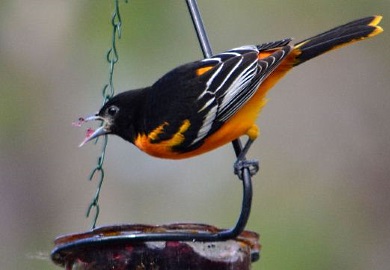DNR News** Archived Article - please check for current information. **
South Carolina has largest number of wintering orioles for third year in a rowMay 3, 2017
Long known for its hospitality to visiting Northerners, South Carolina can now claim to be the state where Baltimore Orioles feel most at home during the winter.
For the third year in a row, South Carolina had the largest number of orioles wintering in the United States. Those results were recorded during the third annual Baltimore Oriole Winter Survey, conducted by the South Carolina Department of Natural Resources (SCDNR) Feb. 17-20. SCDNR's survey was held in conjunction with the Great Backyard Bird Count. Tapping into this longstanding citizen-scientist project allowed SCDNR to get a better picture of the status and distribution of this beautiful songbird wintering in the Palmetto State.

An adult male Baltimore oriole eats grape jelly at a feeder. For the third year in a row, a survey showed South Carolina with the largest number of wintering Baltimore orioles in the United States. (Photo by Jerry Kerschner)
Survey participants in South Carolina submitted 67 reports and tallied 306 orioles. The number of reports was similar to past years, but the number of orioles recorded was noticeably less than last year. This is not too surprising since South Carolina had a mild winter this year. During milder weather, orioles may not frequent feeders as often as they would during colder weather or may be completely absent as they forage for natural foods.
This year, 43 of the 66 participants were new to the survey. Participants counted and recorded the largest number of orioles they could see at one time, on one, two, three or all four days of the survey period. When possible, the age and sex of the orioles were recorded as well.
Orioles were recorded in 16 South Carolina counties and ranged from the Upstate, through the Midlands and along the coast, from North Myrtle Beach to Hilton Head. Charleston County recorded the largest number of orioles in the state, recording more than a third of the total number for the state. Other counties with good numbers of orioles recorded were Dorchester, Sumter and Horry. Reports were received from Newberry and Hampton counties for the first time this year.
There were 228 reports and 773 orioles tallied this year in the United States. These numbers are noticeably down from last year but is also likely due to mild weather. South Carolina had the largest number of reports and orioles tallied in the United States. Orioles were noted from Maine to Florida and over to Texas. Orioles were also noted in Ohio, California and Nova Scotia.
Baltimore Orioles are neotropical migrants, normally wintering in South and Central America and migrating to North America to nest. During the last few decades, however, this species has begun wintering annually in the Southeast. Though scientists are not sure why these birds have begun overwintering, the birds respond well to the popularity of backyard bird feeding. Orioles by nature have a "sweet tooth" and will eat nectar from flowers and wild fruits. Their favorite bird-feeding food by far seems to be grape jelly. Orange halves can be offered, but most orioles tend not to eat them much. People often put oranges out to attract the orioles to the feeding area. Grape jelly will encourage the birds to return. Other items orioles will eat are suet products (homemade, cakes, bark butter, logs, etc.), sugar water (they will drink from hummingbird or oriole nectar feeders), seed mixes (seem to prefer nut and fruit mixes), sliced grapes and mealworms (live or freeze-dried).
"We would like to thank everyone that participated in the survey," said Lex Glover, wildlife technician with the SCDNR Bird Conservation Program. "Your time and efforts are greatly appreciated."
Next year's survey and Great Backyard Bird Count will be Feb. 16-19, 2018. If you have orioles frequenting your feeders or know of someone who does, SCDNR would like to have you participate in the survey. For more information on this survey, contact Lex Glover at GloverL@dnr.sc.gov. For more information on The Great Backyard Bird Count, check out its web page at https://gbbc.birdcount.org/.
| Area | Personnel | Number |
|---|---|---|
| Coastal, Midlands | David Lucas | 843-610-0096 |
| Marine | Erin Weeks | 843-953-9845 |
| Upstate, Midlands | Greg Lucas | 864-380-5201 |
After Hours Radio Room - 803-955-4000
